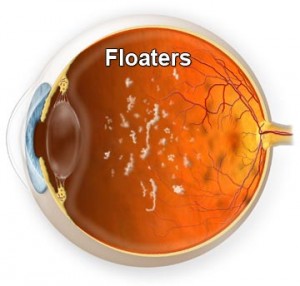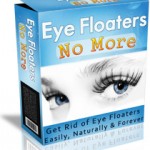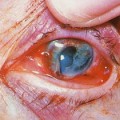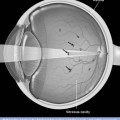Have you been seeing strange things move across your field of vision lately? Do they look like microscopic organisms, or maybe shadowy shapes? If  so, then you might be experiencing floaters in the eye. These can be a nuisance at best, and drive you insane at worse. In this article we’ll look at:
so, then you might be experiencing floaters in the eye. These can be a nuisance at best, and drive you insane at worse. In this article we’ll look at:
- What Are They?
- What Causes Them?
- What You Can Do About Them?
What are Floaters in the Eye?
Floaters in the eye, sometimes known as Myodesopsia, are small moving spots or shadows that appear in your field of vision. They are seen most often when looking at a clear, bright field of vision, such as a large movie screen, or a clear blue sky. They are noticed by:
- Kids as young as 3 (albeit rarely)
- All ages thereafter
- More common in men and women between the ages of 50 -75
Once you notice them they are not likely to go away, especially on their own. They can and do get worse, but usually not to the point of needing to do anything about them. As a matter of fact, it is rare that people seek medical treatment for them once they understand what they are, because floaters in the eye generally don’t interfere with eye sight.
What Causes Floaters in the Eye?
The answer to that requires a little Ocular Anatomy (eye science). There are 5 basic parts to the eye.
- Lens – The focusing mechanism in the center of the eye.
- Cornea – The covering of the eye.
- Iris – This is the part of the eye determines how much light is let into the eye.
- Retina – Located at back of eye, where images are projected.
- Optic Nerve – Sends image to the brain for perception.
- Vitreous Humor – Liquid (gel) that fills eyeball.
It is in the Vitreous that we get Floaters in the eye. And when we say “floaters”, we literally mean floaters. As the eye ages or gets damaged, flecks of tiny collagen fibers slough or tear off in the Vitreous. Once they accumulate enough, they form shadows that block the image projected onto the retina, and form what we call floaters. Imagine watching a movie, but small bits of tissue keep causing shadows on the screen. These particles can be:
- Dots (black, grey, or other dark hue)
- Squiggly lines
- Threadlike
- Threadlike with knots (knobs)
- Transparent
- “Cobweb” like
- Ring shaped
- Odd shapes (probably no two alike)
As for what causes the sloughing or tearing of the Optic Fibers, well Eye Floaters Causes can be a multitude of things:
- Aging
- Wear and tear
- Eye surgery
- Eye disease
- Eye injury/trauma
- Diabetic Neuropathy (nerve cells die)
- Eye infections
What Can You Do About Floaters in the Eye?
When you are deciding what to do about Floaters in the eye, it is important to take inventory of:
- When did they first appear?
- Are they increasing in frequency and intensity?
- Are the floaters associated with pain?
Many cases of Myodesopsia are not a serious threat or inconvenience to the sufferer. It is only noticed occasional and the occurrences are consistent and painless.
Benign Occurrences
- The majority of Myodesopsia is benign. Most people who notice it never seek treatment, or see an optometrist and learn that it is likely not threatening, or harmful.
- Usually no further medical care is needed.
Other cases of Myodesopsia are more serious and require medical attention; in some cases immediate medical attention to avoid blindness.
More Severe Floaters in the Eye
- Notice an immediate onset of floaters in the eye
- Experience pain associated with your Myodesopsia
- If they appear consistently and disturb your vision
- You notice flashes of light in association with your Floaters
Concerns
The reason it becomes so important if you notice any of the symptoms above, is that it could indicate an emerging condition that requires immediate medical attention to avoid permanent damage including blindness. The concerns in these cases are:
- Retinal Detachment
- Retinal Tearing
- Bleeding in the eye
What are the Floaters in the Eye Treatments?
For moderate cases your doctor may prescribe eye drops in an attempt to keep the eye lubricated. This allows blinking and as most Floaters move as the eye moves, it can aid in clearing your vision.
In more severe cases, where there is pain or obvious vision impairment, the optometrist may perform one of the following procedures.
- Vitrectomy – Here the Vitreous Humor and by proxy, the Floaters in the eye are removed and replaced with a saline solution. It is very effective, but expensive and can lead to complications.
- Laser Victreolysis – Using a laser to burn or implode Floaters in the Vitreous. It is still expensive, but much less invasive and therefore less chance of complications.
*WARNING: The following video shows an actual Vitrectomy, not for the squeamish!
Ever Have Floaters in the Eye?
If you’ve ever had Floaters in the eye you know how bothersome it can be. But for most folks it is not a major problem, at least not major enough to seek treatment. But if you suffer from more severe Myodesopsia, then you will need to see your doctor and together you can decide on the best course of treatment for your Floaters in the eye.

Which is NOT a treatment for Myodesopsia?
a. Vitrectomy
b. Eye Drops to Lubricate the Eye
c. Running Water Over Your Eye
d. Laser Vitreolysis
True or False: The Lens covers the eye.
a. True
b. False
What is a Floater in the Eye?
a. Collagen Fibers in the Vitreous
b. An Optic Nerve
c. A Euphemism for a Bowel Movement
d. An Eyelash
Answers at the bottom of the page!

Eye Floaters No More
Daniel Brown spent many years, and lots of his money dealing with Eye Floaters. He even went so far as to have expensive and potentially sight damaging laser treatment, after which he got an infection in his eye. To compound the issue, his Floaters in the eye came back.
• Time
• Hope
All the above . . . wasted. He had almost given up all hope, when he discovered something in the medical journals he had been studying; the result was Eye Floaters No More. What Brown has come up with is a comprehensive system for treatment of those incredibly, irritating menaces to your vision. With Brown’s system you will get:
• A natural way to get rid of Eye Floaters
• A way to do it from your home
• A method to prevent more from occurring
• A way to know if your Eye Floaters are a sign of something more serious
• Two BONUS books: Vision Without Glasses and Stress No More
If you suffer from Myodesopsia then how can you NOT use this product? Not only is it safe and effective, but it costs hundreds of dollars less than more expensive and possibly complicated procedures like a Vitrectomy or Laser Therapy.
At a cost less than $40, and a 60 day 100% money back guarantee, Daniel Brown’s, Eye Floaters No More is something those who suffer from Myodesopsia can’t pass up. Get it today and “see” what everyone is talking about.
Answers: 1) c, 2) b, 3) a








March 19, 2013 at 2:37 pm
Like Sid said, I thought floaters were a sign of something really wrong with my eyes. I’ve had them for as long as I can remember, though they seem to come and go. Or maybe they just float out of my usual range of vision. They’re not that bothersome though.
March 9, 2013 at 5:48 pm
Reading about how these things can be gotten rid of made me feel slightly ill. Sucking out part of the eyeball and replacing it with saline? That sounds like such a drastic operation. I hope my eye floaters never come back or get worse.
March 20, 2013 at 2:45 pm
Yeah, those procedures are rare, but in talking with folks who’ve had it done, it didn’t seem like it was as bad as it sounds. Thanks TMerski
March 7, 2013 at 11:40 pm
When I first noticed floaters in my eyes I thought I had damaged the retinas or something. Of course I immediately started researching online to see if I needed professional help… or worse, had to put my name in for a seeing eye dog. I was so pleased to find your great information, especially the assurance it is not such a serious problem. Nonetheless, I will be trying “Eye Floaters No More” because now that I know the floaters are there I can’t stop looking at them, which I swear is giving me headaches.